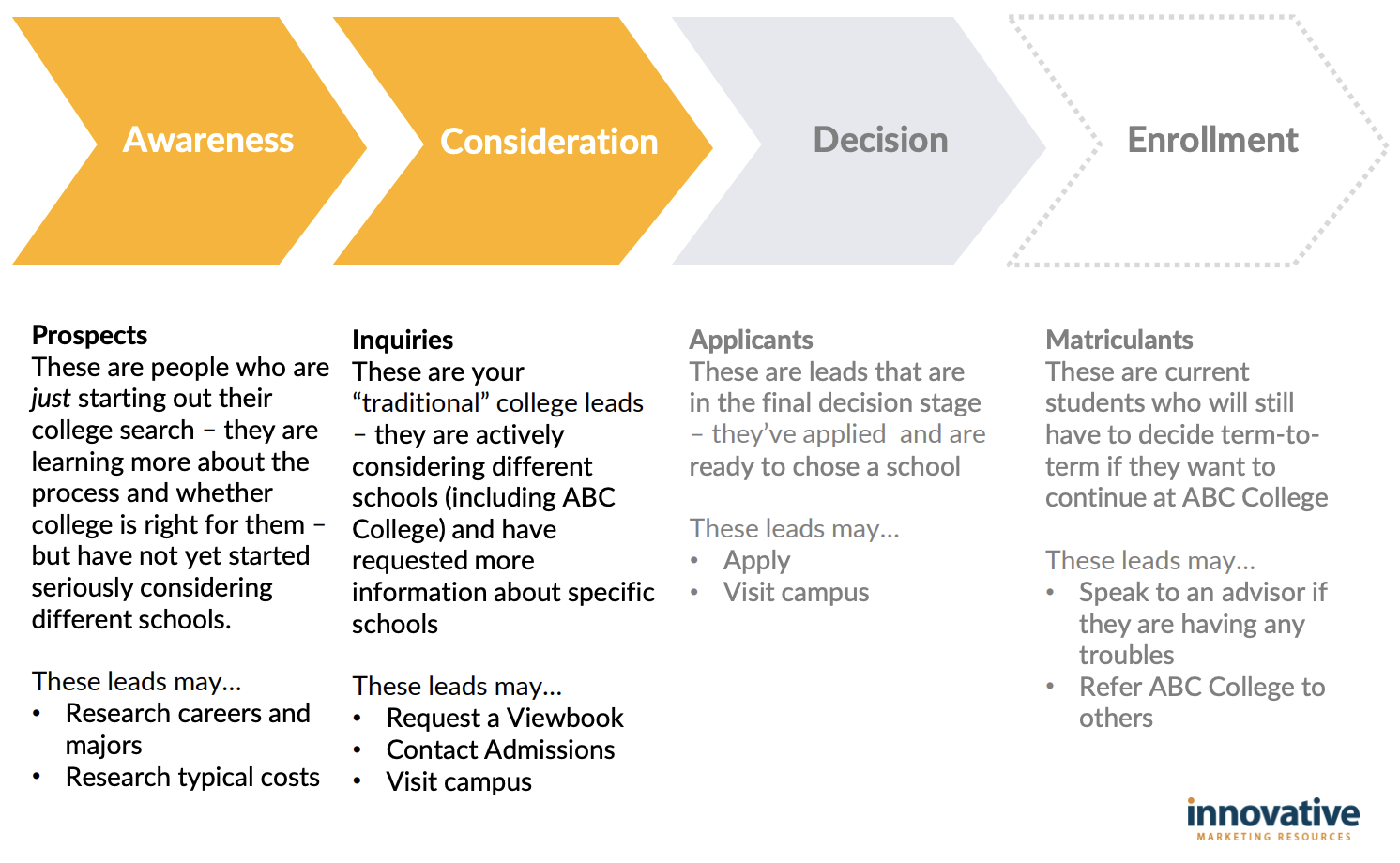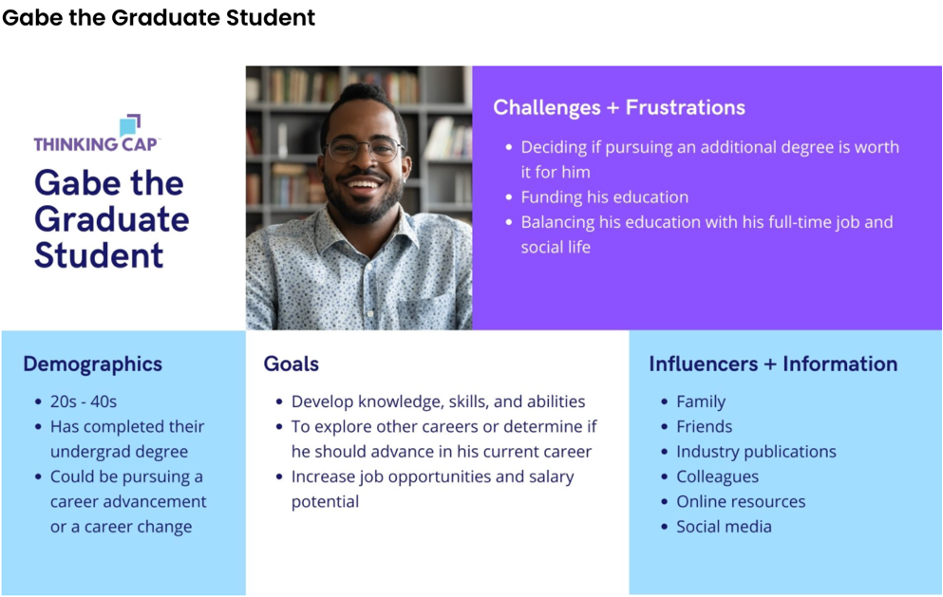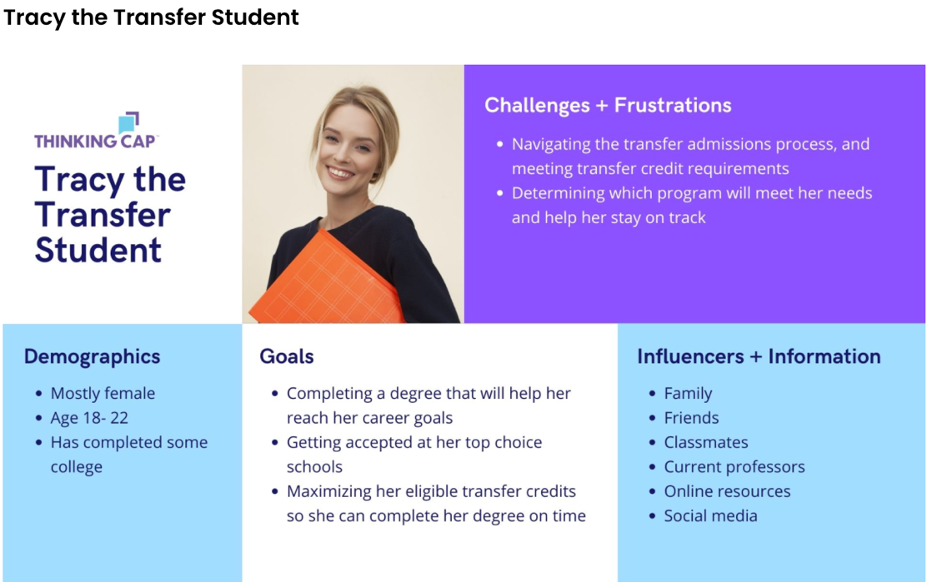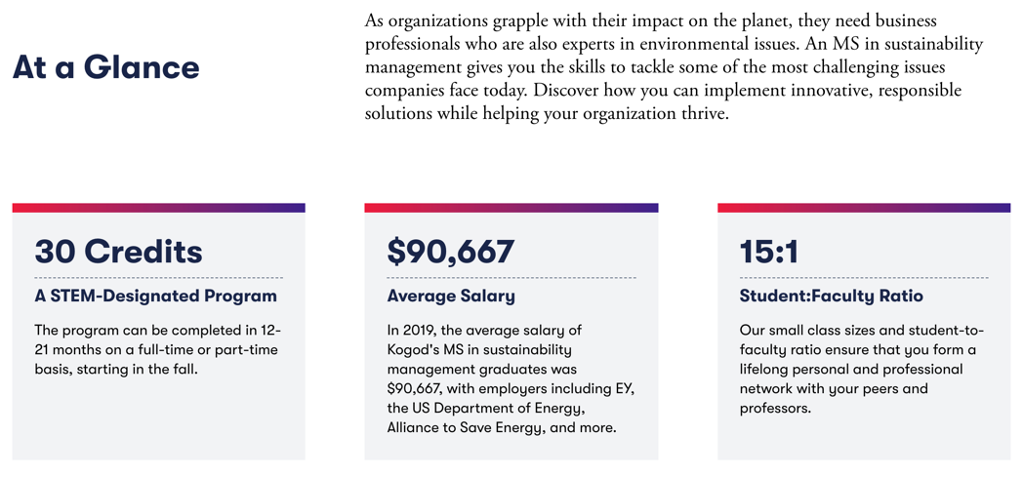To boost enrollments, your higher education institution must create and use student personas. These mini-profiles offer in-depth insight into students’ motivations, allowing for more personalized and targeted outreach. Customized content is key to improving sales (and enrollments).
Crafting college student personas is an art and a science. We’ve created this guide to help you strike the balance between both.
What are student personas?
A student persona is a fictional representation of your prospective student. Personas group students into different categories, each representing a distinct segment of the student body.
Schools typically create many different personas. Depending on your school’s enrollment priorities, you may segment students into a variety of categories, including:
- Program of interest
- Geographic location
- Career goals
- Age or life stage
The buyer’s journey
Student personas are an example of a real student and their ‘buying’ (decision-making) process – how, when, and why they make a college decision.
Student Personas Overview, by IMR
Like buyer personas, which profile a business’s customers, student personas outline a student’s “buyer’s journey.” Personas provide data on the student experience at each point of the college decision-making process, from awareness to enrollment.

By understanding students’ needs at different points in time, schools can use personas to determine the ideal way to reach prospective students.
What to include in a student persona
A student persona often includes:
- A name and short biography
- Demographic information, such as age, gender, or income level
- Goals, motivations, and challenges
- Go-to sources for information
- Quotes from interviews, if conducted
Goals, motivations, and challenges is the most important category. In IMR’s blog post* on student personas, the author warns against personas becoming “a smattering of demographic information.” Personas should cover the “what, where, why, and how” of the college search process.
(*Source: https://www.imrcorp.com/inbound-for-higher-ed-blog/what-are-prospective-student-personas)
The key questions to answer, which directly tie to the buyer’s journey, include:
- What are [students] hoping to gain from their experience?
- Where do they turn to for information?
- Why are they looking at colleges?
- How do they define success?
Student persona examples
Here’s an example from Thinking Cap, a national higher education marketing agency.

The persona provides a brief sketch of Gabe’s life stage and pain points, as well as what he hopes to accomplish. We know he is motivated to explore other careers and increase job opportunities. We also understand which sources likely influence Gabe’s decision-making.
Tracy the Transfer Student is also a strong example.

Tracy is between the ages of 18 and 22 and is driven by a desire to fulfill her career goals. She’s apprehensive of navigating the transfer admissions process, though, and is unsure how to select the best program. She typically turns to social media, online resources, and family and friends for information.
How to create a student persona
1. Analyze your current data
Start with what you have. Work with your school’s admissions and marketing teams to collect current data on students. You might also consider consulting instructors to confirm different characteristics or trends.
Next, begin segmenting students into different groups. Segmentation is the first step toward identifying commonalities in your target audience. Keep things simple by selecting broad categories, like international or second career students.
2. Conduct qualitative research with students
Once you’ve segmented your target audience, connect with students to fill in any research gaps. Asking more personalized questions will help foster a more nuanced understanding of students’ mindsets. Conducting qualitative research will also help you avoid assumptions.
Potential research methods include:
- Holding a focus group
- Posting questions or prompts on social media
- Asking research questions on application or inquiry forms
Depending on your focus, questions might include:
- Do you work full or part-time?
- When did you last attend school?
- What do you find most challenging about resuming your education?
- How do you balance work, family, and school?
- What do you consider the most important job in your profession?
3. Gather market research
Round out your analysis with publicly available market research on your student population. This helps put your original research in the context of current or emerging trends. Additional research also ensures you’ve included any data missing from your database or qualitative interviews.
Sources could include:
- White papers by collegiate marketing or research groups
- Surveys conducted with students
- Industry blogs
How to use student personas
Customers and students alike are most responsive to customized content. Students expect content, such as emails or social media posts, to meet their specific needs at specific times. Student personas provide essential data to meet these expectations.
Student personas can be leveraged to create targeted marketing campaigns that speak to students’ motivations, concerns, and interests.
Take this webpage by American University’s Kogod School of Business as an example. The page targets prospective students for Kogod’s master of science in sustainability management (MSSM) program.

Kogod School of Business in Washington, DC, uses student personas to customize its website messaging.
Based on their personas, Kogod understands prospective MSSM students are driven to acquire “hard,” STEM-focused skills. The web page focuses on the business skills students will gain in the program. The page also addresses three key concerns: program length, salary potential, and student-faculty ratio.
Other content you might customize includes:
- Email campaigns addressing prospective students’ concerns
- eBooks which answer students’ common questions
- Motivations-based messaging for social media
- Blog posts profiling current students
Like any marketing effort, you’ll want to track results and update your personas as your knowledge evolves. Evaluate student personas periodically, especially when new degree programs or courses are launched.
Optimize your enrollments
A strong enrollment marketing strategy has many components, including well-researched student personas. To optimize enrollments, schools must conduct targeted outreach driven by customized content. Student personas are your lifeblood.









